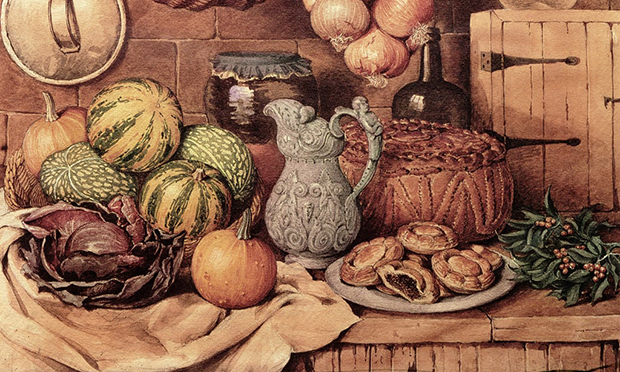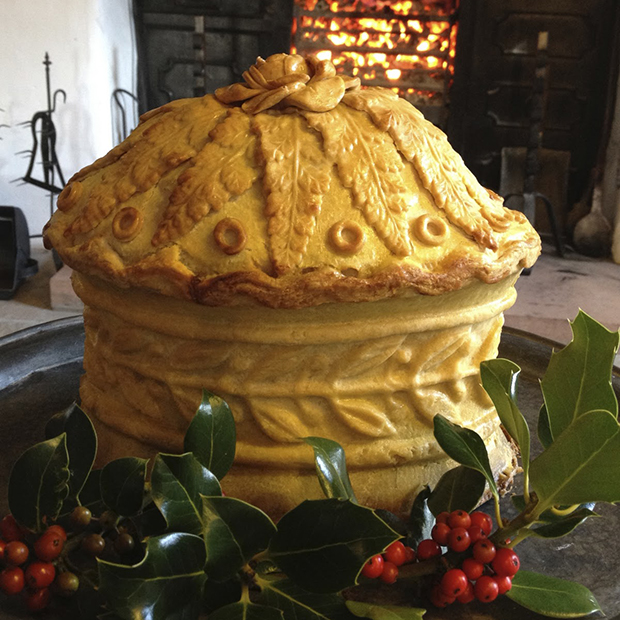The Pies Have It

Mary Ellen Best’s Still Life with Christmas Food
Mary Ellen Best painted a somewhat sombre work named Still life with Christmas food, which shows little of the festive food we expect, except for a dish of rugged mince pies and a large decorated pork pie along with various winter vegetables.
Ellen was born in 1809 to a comfortably well-off family in York. Her education included lessons in drawing and painting in watercolours, a suitable pastime for young ladies, but for Ellen a serious professional skill. She enjoyed painting and was determined to be taken seriously as an artist, doing portraits of family and friends and later local commissions, and a series of delightful domestic interiors – kitchens, dining rooms and parlours, with a cheerful pleasure in the cacophony of brightly patterned carpets, wallpaper and curtains she and her family loved. The painting of herself at work in her ‘painting room’ gives an idea of her skills and personality – independent, cheerful and good-looking.
She had an inherited income that allowed her to travel independently all over Europe, where she eventually settled with her devastatingly handsome German husband and three children.
Caroline Davidson’s book, The World of Mary Ellen Best, has a wonderful selection of her work and a detailed biography, which explains how Ellen enjoyed an independent life between easy-going regency jollity and restrictive Victorian conformity.
The drab pork pies in her still life indicate relaxed neighbourly hospitality rather than posh dining, and the vegetables, claggy with the heavy soil of the plain of York, would have been delicious roasted. There is no sign of the expected turkey or goose, or joint of beef. The carefully locked cupboard on the right might contain these precious items, but the emphasis does seem to be on the pies.
The answer could be, as our foremost food historian Ivan Day points out on his blog and website, Food History Jottings, that before the dead hand of the conventional Victorian Christmas dinner fell upon us, the eating, drinking and merriment were spread over several days.

A Christmas pie made by Ivan Day. Photograph: courtesy Ivan Day
Small pies and large ones, with a variety of fillings, were part of an overall attempt to mitigate the winter gloom during the ‘Twelve Days of Christmas’, with seasonable treats and comforts, and as much riotous living as we could afford, spread over several days but with no rigid pattern.
Store cupboards were full of summer and autumn food: pickles, fruit in syrup, salted and dried meat and fish, baked goods for keeping, fattened geese and plump turkeys, capons, game birds and wild meat. They were something to enjoy while they were at their peak of perfection, and made welcome gifts, packed into an airtight protective pastry crust, juices drained away and replaced with clarified butter, the archetypal pie and Christmas gift, as explained brilliantly by Ivan in his demonstrations of pie-making and meat-roasting. The pie was a way of creating a long-lasting source of pleasure or the ideal Christmas food, a perfect gift or a domestic treat.
Nowadays we seem to have succumbed to the myth of an ancient and immutable Christmas tradition, whose rigid structure has in fact only been around a relatively short while.
The villains are Charles Dickens and Albert Prince Consort, who seem to have created a conventional structure which has tyrranised young and old, mercifully for only a few generations. Bob Cratchett’s family, poor but honest, eventually tucking in to a turkey with all the trimmings, in alliance with the Prince’s importation of the decorated Christmas tree, groaning with gaudy decorations and obligatory presents, has now become the standard Christmas ritual. The menu for the festive meal fossilised in a conventional line-up of obligatory ingredients, not ideal companions. The turkey on its own with a modest green salad and a few roast parsnips doesn’t have to compete with all the add-ons, and the pudding, and the mince pies.
Ellen’s little pies were probably small versions of the huge enigmatic meat and sweet fruit pies that appeared 200 years earlier in paintings in the Netherlands. Large ornate structures, with a great gash in the pastry covering to reveal the luxurious contents: a mixture of meat, dried and candied fruits, olives, chestnuts, dates, thick rich gravy or jelly, spices and pine nuts. These were enjoyed all year round by affluent Dutch merchants, but not intended as Christmas food. Ellen knew these still lifes from her travels in Europe, and would not be as surprised as we are by the mixture of meat and sweet things in the fillings.
